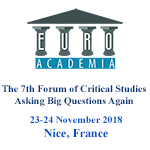Euroacademia Conferences
 Europe Inside-Out: Europe and Europeanness Exposed to Plural Observers (9th Edition) April 24 - 25, 2020
Europe Inside-Out: Europe and Europeanness Exposed to Plural Observers (9th Edition) April 24 - 25, 2020 Identities and Identifications: Politicized Uses of Collective Identities (9th Edition) June 12 - 13, 2020
Identities and Identifications: Politicized Uses of Collective Identities (9th Edition) June 12 - 13, 2020 8th Forum of Critical Studies: Asking Big Questions Again January 24 - 25, 2020
8th Forum of Critical Studies: Asking Big Questions Again January 24 - 25, 2020 Re-Inventing Eastern Europe (7th Edition) December 13 - 14, 2019
Re-Inventing Eastern Europe (7th Edition) December 13 - 14, 2019 The European Union and the Politicization of Europe (8th Edition) October 25 - 26, 2019
The European Union and the Politicization of Europe (8th Edition) October 25 - 26, 2019 Identities and Identifications: Politicized Uses of Collective Identities (8th Edition) June 28 - 29, 2019
Identities and Identifications: Politicized Uses of Collective Identities (8th Edition) June 28 - 29, 2019 The European Union and the Politicization of Europe (7th Edition) January 25 - 26, 2019
The European Union and the Politicization of Europe (7th Edition) January 25 - 26, 2019 7th Forum of Critical Studies: Asking Big Questions Again November 23 - 24, 2018
7th Forum of Critical Studies: Asking Big Questions Again November 23 - 24, 2018 Europe Inside-Out: Europe and Europeanness Exposed to Plural Observers (8th Edition) September 28 - 30, 2018
Europe Inside-Out: Europe and Europeanness Exposed to Plural Observers (8th Edition) September 28 - 30, 2018 Identities and Identifications: Politicized Uses of Collective Identities (7th Edition) June 14 - 15, 2018
Identities and Identifications: Politicized Uses of Collective Identities (7th Edition) June 14 - 15, 2018
Papers
Feminist Epistemology: Coping with the Collapse of a Objective Value Free Epistemology
The collapse of the ideal of a value free epistemology has been a central topic in Feminism. In response to this epistemological fall out, Feminism has developed both theoretical and ground level tools for exploring epistemological disagreements without the need for idealized deliberation or intentional communicative action. Neither the condition of epistemological reflexivity nor the heterogeneous relevance of values can alone justify a non-foundational method for the feminist epistemology.Scientific Visualisations of Urban Heritage as Identity Making Image Construction
In the context of scientifically visualizing hypotheses of archaeology and art history we have developed a method for visualizing urban transformations that focus on structural features enabling to get historic shapes with a minimum of fictional content. It consists of two complementary parts: virtual modeling and virtual photography. Contrasting the geometric abstraction of the model, strictly based on the verbal hypotheses, our way of depicting the scenery uses traditional methods of realistic architectural photography.Pompa Introitus Honori Serenissimi Principis Ferdinandi Austriaci Hispaniarum Infantis. Cardinal-Infante Don Ferdinand’s Triumphal Entry in Antwerp in 1635
On May 15, 1635, cardinal-infante don Ferdinand made his triumphal entry in Antwerp as the new governor of the Spanish Netherlands after his victory in Nördlingen against the Swedish and his allies of Saxony. The city, which was going through very delicate moments to maintain its previous commercial relevancy, decided to devote its economic and intellectual energies to this celebration with the aim of impressing don Ferdinand, from whom they were expecting protection.Made in Transit: Politics and Representation in Adrian Paci, Contemporary Art and the Migration Issue
Narratives of place and displacement, and their relationship with the identity making process, occupy nowadays a central position towards the definition of contemporary art. The aim of this article is to analyze the current relationship between economic, social and political conflicts and representational systems in the realm of contemporary art. The work of Adrian Paci, his creative thought and process question, among other issues, the realm of transitional belonging as we can see in projects such as The Column (2013) or Centro di Permanenza Temporanea (2007).Utopian Territories: Space and Place within Contemporary Installation
How has the globalised world affected utopian ideas which are increasingly further away from a singular utopian nation? This paper aims to examine the inner workings of installation as a group territory and how we may explore and locate a contemporary version of utopia within the spatial boundaries of the gallery. In what ways do artists utilise space and object to encourage the experiencer to act as a key participant and test out new and imaginative possibilities? Finally, what futures are suggested in contemporary practices for the globalised utopian and the potentially humane world of installation?Art and the Creation of National Identities in Europe : Art in Colonial Cyprus In Search of Identity Before Independence
Studying and examining the work of Adamantios Diamantis, Tilemachos Kanthos, George Pol Gheorghiou, Christoforos Savva, Stass Paraschos and others from the dawn of the 20th century till the independence (1959), we can observe the artists' sincere concern about defining their place in the world, their own identity. From 1900 to 1974, we see a significant number of artworks that try to give answers to questions such 'what is Cyprus?', 'where do Cyprus and its people belong?'. The Cypriot identity making issue is visibly central to artistic concerns of the first half of 20th Century.Painting Difference: European Collections, Identities and Future Histories
Digital tools provide new opportunities to look at cultural data, enabling us to observe our patterns of acquisition and sharing in different ways. Our identity as European draws upon cultural, religious and social practices that have been shaped by migration and diasporic activity from both within and beyond the borders of Europe. Traditional disciplinary models have centuries-old practices and ways of working but new technologies, as with the advent of photography, enable us to look at the manifestations of culture using a different, digital, lens.Reclaiming Ishbal: Opposing European Dominance in Hiromu Arakawa’s Fullmetal Alchemist
This talk explores Europe's portrayal as a violent, militaristic, colonizing force from the perspective of a Japanese manga. Hiromu Arakawa's manga series Fullmetal Alchemist (2001-2010) is set in Amestris, a fictional country where alchemy has become one of the most advanced sciences. Throughout the series, Arakawa establishes an analogy between Amestris and an early twentieth-century European country by portraying street signs and official documents in English, using German, Dutch or English names for main characters, and drawing similarities between the militaristic regime of Fuhrer President King Bradley and Nazi Germany.Alhambrism in Russian Architecture: The Islamic Heritage in Europe and Its Rediscovery in the Nineteenth Century
The fact that the Alhambra’s architecture was also heavily adopted in Tsarist Russia is nearly absent from the non-Russian scholarly literature. Focusing on Russian examples, my paper considers the phenomenon of the Moorish Revival from an unusual perspective. It highlights its extent and complexity, briefly referencing its diverse manifestations in Europe, but also insisting on its consistency. Islamic landmarks were part of the European cultural heritage, and the neo-Moorish style was part of the common European patrimony. This was the result of both close connections between countries and far-reaching cultural transfers in art.Reproducing Europe: The Old World Wine Rhetorics of a New World Wine Region
Based on over 80 site visits to Appalachian wineries; rhetorical analyses; and interviews with wine makers, wine associations, and government officials involved in wine promotion, this paper will examine the ways that reproduced Italian and French cultural signifiers work to legitimize an unrecognized wine region through cultural appropriation and association. Furthermore, this paper will argue that commodified notions of Old World Europe represent a new formation of North American place-making that is simultaneously derivative and inimitable (as well as local and global) in its adaptation.




